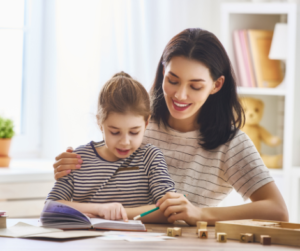Language Arts is plural because it is a subject that covers many different areas, skills, and abilities. Parents worry a lot about this subject and if they are doing enough. The truth is your child is constantly picking up language skills. Some skills need explicit teaching but others seem to happen magically. Let’s break down some of the skills your child needs, and when it makes sense to worry about them.
Comprehension
 Reading comprehension is a critical skill that you can help your child start to develop long before they start reading. All you need to do is read to them and discuss the story. Pick a picture book and ask your child to look for things in the pictures. Ask them how the characters are feeling. Ask what they think will happen next. Ask them easy questions they can answer and, when they are good at those, ask them questions that make them think. Reading comprehension is the skill of understanding the information you are reading, but before you do that, you need to understand what other people read to you.
Reading comprehension is a critical skill that you can help your child start to develop long before they start reading. All you need to do is read to them and discuss the story. Pick a picture book and ask your child to look for things in the pictures. Ask them how the characters are feeling. Ask what they think will happen next. Ask them easy questions they can answer and, when they are good at those, ask them questions that make them think. Reading comprehension is the skill of understanding the information you are reading, but before you do that, you need to understand what other people read to you.
This skill can be more deeply developed by reading books, magazine articles, or even recipes together and discussing them. As your child grows, be sure to read more complex books together so that your child learns to look for information in their test. Reading simple mysteries are a great way to learn to look for clues in the text.
Vocabulary
The easiest way to help your children have a strong vocabulary is to use a good vocabulary around them. Yes, you may have to explain what the larger words mean, but that is how they will learn to use those words for themselves. There is no reason to dumb down your word choices for your child, even as toddlers, the more words they hear, the more they will learn. If you worry that your own vocabulary isn’t expansive, all you need to do is read out loud to your child. Books are full of words we don’t use in everyday life, even picture books.
Grammar
 Grammar can be a lot of things, but the first and most important part of learning grammar is learning to speak with good grammar. Teach your child to use the correct subject and verb tense together. While it is normal for children just learning to speak to muddle those things, by age 5, your child should be able to use the right verb tense in most situations.
Grammar can be a lot of things, but the first and most important part of learning grammar is learning to speak with good grammar. Teach your child to use the correct subject and verb tense together. While it is normal for children just learning to speak to muddle those things, by age 5, your child should be able to use the right verb tense in most situations.
As students grow, grammar lessons can include many different things. Some of it is memorization, like learning what is a noun and what is a verb. In my experience, those are things that are nice to introduce through Mad Libs in elementary school. But most kids won’t really remember all those definitions until middle or high school. So, don’t stress this part, and be prepared to go over it a few times.
Grammar also includes things like punctuation and capitalization. Those are important to teach as you teach your child to write. Copywork is a great way to introduce these things and you don’t need a fancy curriculum for that. However, I also like the program Grammar with a Giggle, for older children who need a little grammar instruction.
Handwriting
Handwriting is an often overlooked, yet essential, part of language arts. I believe it is important to take the time to teach your child how to write each letter. It is important to do this until they memorize how to make the letters and do it consistently. That can take far longer than most schools today spend on this vital skill. I also recommend making handwriting a regular part of your child’s school day up through at least middle school. Do you know why grandmothers have such lovely handwriting? Because they had penmanship classes up through high school. They were given time and instruction to learn to write neatly. It did not happen by magic. For most students, just 5 minutes a day of working on handwriting will help them to improve.
Reading
 Reading is an essential skill to have, but your brain has to be ready to learn it. This is a skill we are now pushing kids to learn to do younger and younger, even if they are not ready. Most children tend to be ready to start learning to read between the ages of 6 and 8. If your child is having a hard time remembering which letter is which or which sound they make, an Orton-Gillingham-based program is the best choice for teaching a phonics-based reading program. Actually, all children would benefit from that type of instruction, but the dyslexic ones really need the method to help them learn to decode words.
Reading is an essential skill to have, but your brain has to be ready to learn it. This is a skill we are now pushing kids to learn to do younger and younger, even if they are not ready. Most children tend to be ready to start learning to read between the ages of 6 and 8. If your child is having a hard time remembering which letter is which or which sound they make, an Orton-Gillingham-based program is the best choice for teaching a phonics-based reading program. Actually, all children would benefit from that type of instruction, but the dyslexic ones really need the method to help them learn to decode words.
Spelling
Spelling is a combination of several skills and relies heavily on memory. You have to remember how to make each letter and what sounds it makes. You have to remember the many, many rules of English spelling or just memorize how to spell every word. Students who struggle with their memory will struggle with spelling. Playing games with visual memory, like the game Memory, can actually help your child with spelling in the long run.
Independent Writing
 To write stories, essays, or even poems, children need to have developed all the skills above. This is why I believe in writing for children as much as they need in the early years. It is just too much to expect a young child to have developed so many skills. They need time and instruction to gain each of those skills. This is also why homeschooled children vary so much in the realm of language arts. They are each allowed to grow at their own pace in this area, and some are going to go faster than others. Some kids pick up language and all the rules that go with it easily, and some have a harder time.
To write stories, essays, or even poems, children need to have developed all the skills above. This is why I believe in writing for children as much as they need in the early years. It is just too much to expect a young child to have developed so many skills. They need time and instruction to gain each of those skills. This is also why homeschooled children vary so much in the realm of language arts. They are each allowed to grow at their own pace in this area, and some are going to go faster than others. Some kids pick up language and all the rules that go with it easily, and some have a harder time.
How long it takes your student to gain all of those skills and be ready to write is very individual. And it is okay if they are in high school before they can put all those skills together well to write longer assignments. The important part is that they can do it by the time they graduate.
You have twelve years to teach all of those skills and get your student writing at the level they need for college or adulthood. Don’t be stressed they aren’t ready to do that at age 8 or 12. Just keep teaching and plan to put it all together by the end of high school.





0 Comments